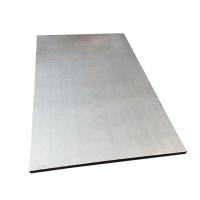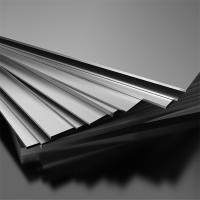Stainless steel thick plate refers to a stainless steel plate with
a thickness of more than 25mm.
Successfully rolled a 200mm thick stainless steel super-thick plate
The physical properties of each chemical element of the stainless
steel plate and the function of each element:
1. Carbon (C): The carbon content in the steel increases, the yield
point and tensile strength increase, but the ductility and impact
decrease. When the carbon content exceeds 0.23%, the welding
performance of the steel deteriorates, so the low welding
performance is used for welding. Alloy structural steel, carbon
content generally does not exceed 0.20%, high carbon content will
also reduce the atmospheric corrosion resistance of steel, high
carbon steel in the open stock yard is easy to rust; in addition,
carbon can increase the cold brittleness and aging sensitivity of
steel sex.
2. Silicon (Si): Silicon is added as a reducing agent and
deoxidizer in the steelmaking process, so killed steel contains
0.15-0.30% silicon. If the silicon content in the steel exceeds
0.50-0.60% silicon, it is regarded as an alloying element. Silicon
can significantly improve the elastic limit, yield point and
tensile strength of steel, so it is widely used as spring steel.
Adding 1.0-1.2% silicon to the quenched and tempered structure can
increase the strength by 15-20%. The combination of silicon and
molybdenum, tungsten, chromium, etc. can improve corrosion
resistance and oxidation resistance, and can manufacture
heat-resistant steel. Low carbon steel containing 1-4% silicon,
with extremely high magnetic permeability, used in electrical
industry to make silicon steel sheets. An increase in the amount of
silicon will reduce the weldability of the steel.
3. Manganese (Mn): In the steelmaking process, manganese is a good
deoxidizer and desulfurizer. Generally, the steel contains
0.30-0.50% of manganese. When more than 0.70% is added to carbon
steel, it is considered "manganese steel", which not only has
sufficient toughness, but also has higher strength and hardness
than ordinary steel, which improves the hardenability of steel and
improves the hot workability of steel. For example, the yield point
of 16Mn steel is 40% higher than that of A3. Steel containing
11-14% manganese has extremely high wear resistance and is used for
excavator buckets, ball mill linings, etc. The increase of
manganese content weakens the corrosion resistance of steel and
reduces the welding performance.
4. Phosphorus (P): In general, phosphorus is a harmful element in
steel, which increases the cold brittleness of steel, deteriorates
the welding performance, reduces the plasticity, and deteriorates
the cold bending performance. Therefore, the phosphorus content in
steel is usually required to be less than 0.045%, and the
requirements for high-quality steel are lower.
5. Sulfur (S): Sulfur is also a harmful element under normal
circumstances. It makes the steel hot brittle, reduces the
ductility and toughness of the steel, and causes cracks during
forging and rolling. Sulfur is also detrimental to weldability,
reducing corrosion resistance. Therefore, the sulfur content is
usually required to be less than 0.055%, and the high-quality steel
is required to be less than 0.040%. Adding 0.08-0.20% sulfur to
steel can improve machinability, usually called free-cutting steel.
6. Chromium (Cr): In structural and tool steels, chromium can
significantly improve strength, hardness and wear resistance, but
at the same time reduce ductility and toughness. Chromium can also
improve the oxidation resistance and corrosion resistance of steel,
so it is an important alloying element of stainless steel and
heat-resistant steel.







